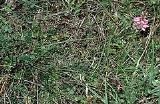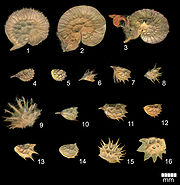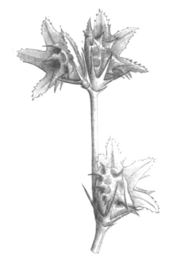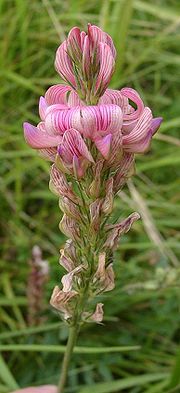
Sainfoin
Encyclopedia
Onobrychis, the Sainfoins, are Eurasia
n perennial
herb
s of the legume family
(Fabaceae
). Including doubtfully distinct species
and provisionally accepted taxa, about 150 species are presently known. The Flora Europaea
lists 23 species of Onobrychis; the main centre of diversity extends from Central Asia
to Iran
, with 56 species – 27 of which are endemic – in the latter country alone. O. viciifolia
is naturalized throughout many countries in Europe
and North America
grassland
s on calcareous soils.
as far north as southern Sweden
. These plants grow on grassland
, agricultural land
and wasteland. The leaves are pinnate
, alternate, with 6 to 14 pairs of oblong to linear leaflets. Sainfoins have pale pink flowers, typically blooming between June and September and pollinated by honey bee
s and solitary bees. The rounded single-seeded pods bear prominent spikes or similar protrusions in many species, enabling them to cling to the fur
of large mammal
s and be thus distributed.
These highly nutritious plant
s were an important forage
for heavy working horses in agriculture
, and are still an excellent source of nectar for honey
production as well as pollen
for bee food. Because sanfoins are rich in tannins which protect protein
s from hydrolysis
in the rumen
, the proteins are instead absorbed in the abomasum
. Onobrychis typically have a deep taproot
and so are very drought
resistant, but do not recover well from overgrazing
. Adapted to slow but steady growth in the arid
steppe
belt of Eurasia
, sainfoins are difficult to establish as pasture, are not persistent in grassland, and only yield one crop of hay
or seed
s per year. Thus they are seldom grown in any significant extent, though O. viciifolia
is met with somewhat more regularly.
Onobrychis species are used as food plants by the caterpillar
s of some Lepidoptera
species, such as the case-bearer moth
Coleophora colutella
(recorded on O. saxatilis) and the Damon Blue (Polyommatus damon) butterfly
.
ónos (ὄνος, "donkey") and brýkein (βρύκειν, "to eat greedily"). This refers to sainfoin's good properties as a forage plant for large mammalian herbivore
s.
Sainfoin is derived from Old French
sain foin ("healthy hay
"). In the words of the 16th-century soil scientist Olivier de Serres
:
In northern European languages that have been less influenced by French, the plants' name usually derives from esparceto, the Provençal term for the similar-looking and closely related sweetvetches (Hedysarum). Examples are Danish esparsette, Dutch esparcette, German Esparsette, Lithuanian
esparceta, Polish sparceta, Russian espartset (Эспарцет) and Swedish esparsett. Meanwhile, the Occitan name of sainfoin, luzerne, has in many languages come to mean species of the related genus Medicago
, in particular Alfalfa
(M. sativa).
The native name of the Cock's Head (O. caput-galli) is one of the few words of the extinct
Dacian language
that have been recorded. The Dacians called this plant aniarsexe or aniassexie.
In George Orwell
's Coming Up for Air
, travelling salesman George Bowling regularly reminisces about the smell of sainfoin in his father's seed shop in Lower Binfield.
are considered at least provisionally valid by the International Legume Database & Information Service; some notable subspecies
are also listed:



Eurasia
Eurasia is a continent or supercontinent comprising the traditional continents of Europe and Asia ; covering about 52,990,000 km2 or about 10.6% of the Earth's surface located primarily in the eastern and northern hemispheres...
n perennial
Perennial plant
A perennial plant or simply perennial is a plant that lives for more than two years. The term is often used to differentiate a plant from shorter lived annuals and biennials. The term is sometimes misused by commercial gardeners or horticulturalists to describe only herbaceous perennials...
herb
Herb
Except in botanical usage, an herb is "any plant with leaves, seeds, or flowers used for flavoring, food, medicine, or perfume" or "a part of such a plant as used in cooking"...
s of the legume family
Family (biology)
In biological classification, family is* a taxonomic rank. Other well-known ranks are life, domain, kingdom, phylum, class, order, genus, and species, with family fitting between order and genus. As for the other well-known ranks, there is the option of an immediately lower rank, indicated by the...
(Fabaceae
Fabaceae
The Fabaceae or Leguminosae, commonly known as the legume, pea, or bean family, is a large and economically important family of flowering plants. The group is the third largest land plant family, behind only the Orchidaceae and Asteraceae, with 730 genera and over 19,400 species...
). Including doubtfully distinct species
Species
In biology, a species is one of the basic units of biological classification and a taxonomic rank. A species is often defined as a group of organisms capable of interbreeding and producing fertile offspring. While in many cases this definition is adequate, more precise or differing measures are...
and provisionally accepted taxa, about 150 species are presently known. The Flora Europaea
Flora Europaea
The Flora Europaea is a 5-volume encyclopedia of plants, published between 1964 and 1993 by Cambridge University Press. The aim was to describe all the national Floras of Europe in a single, authoritative publication that helped readers identify any wild or widely cultivated plant in Europe to the...
lists 23 species of Onobrychis; the main centre of diversity extends from Central Asia
Central Asia
Central Asia is a core region of the Asian continent from the Caspian Sea in the west, China in the east, Afghanistan in the south, and Russia in the north...
to Iran
Iran
Iran , officially the Islamic Republic of Iran , is a country in Southern and Western Asia. The name "Iran" has been in use natively since the Sassanian era and came into use internationally in 1935, before which the country was known to the Western world as Persia...
, with 56 species – 27 of which are endemic – in the latter country alone. O. viciifolia
Onobrychis viciifolia
Onobrychis viciifolia is a species of legume known by the common name sainfoin; other species in genus Onobrychis may be known by this name as well. Other common names for this species include esparcet and pipirigallo. This is a perennial herb which is native to Eurasia, but it is widely cultivated...
is naturalized throughout many countries in Europe
Europe
Europe is, by convention, one of the world's seven continents. Comprising the westernmost peninsula of Eurasia, Europe is generally 'divided' from Asia to its east by the watershed divides of the Ural and Caucasus Mountains, the Ural River, the Caspian and Black Seas, and the waterways connecting...
and North America
North America
North America is a continent wholly within the Northern Hemisphere and almost wholly within the Western Hemisphere. It is also considered a northern subcontinent of the Americas...
grassland
Grassland
Grasslands are areas where the vegetation is dominated by grasses and other herbaceous plants . However, sedge and rush families can also be found. Grasslands occur naturally on all continents except Antarctica...
s on calcareous soils.
Description, ecology and uses
Sanfoins are mostly subtropical plants, but their range extends throughout EuropeEurope
Europe is, by convention, one of the world's seven continents. Comprising the westernmost peninsula of Eurasia, Europe is generally 'divided' from Asia to its east by the watershed divides of the Ural and Caucasus Mountains, the Ural River, the Caspian and Black Seas, and the waterways connecting...
as far north as southern Sweden
Sweden
Sweden , officially the Kingdom of Sweden , is a Nordic country on the Scandinavian Peninsula in Northern Europe. Sweden borders with Norway and Finland and is connected to Denmark by a bridge-tunnel across the Öresund....
. These plants grow on grassland
Grassland
Grasslands are areas where the vegetation is dominated by grasses and other herbaceous plants . However, sedge and rush families can also be found. Grasslands occur naturally on all continents except Antarctica...
, agricultural land
Agricultural land
Agricultural land denotes the land suitable for agricultural production, both crops and livestock. It is one of the main resources in agriculture...
and wasteland. The leaves are pinnate
Pinnate
Pinnate is a term used to describe feather-like or multi-divided features arising from both sides of a common axis in plant or animal structures, and comes from the Latin word pinna meaning "feather", "wing", or "fin". A similar term is pectinate, which refers to a comb-like arrangement of parts...
, alternate, with 6 to 14 pairs of oblong to linear leaflets. Sainfoins have pale pink flowers, typically blooming between June and September and pollinated by honey bee
Honey bee
Honey bees are a subset of bees in the genus Apis, primarily distinguished by the production and storage of honey and the construction of perennial, colonial nests out of wax. Honey bees are the only extant members of the tribe Apini, all in the genus Apis...
s and solitary bees. The rounded single-seeded pods bear prominent spikes or similar protrusions in many species, enabling them to cling to the fur
Fur
Fur is a synonym for hair, used more in reference to non-human animals, usually mammals; particularly those with extensives body hair coverage. The term is sometimes used to refer to the body hair of an animal as a complete coat, also known as the "pelage". Fur is also used to refer to animal...
of large mammal
Mammal
Mammals are members of a class of air-breathing vertebrate animals characterised by the possession of endothermy, hair, three middle ear bones, and mammary glands functional in mothers with young...
s and be thus distributed.
These highly nutritious plant
Plant
Plants are living organisms belonging to the kingdom Plantae. Precise definitions of the kingdom vary, but as the term is used here, plants include familiar organisms such as trees, flowers, herbs, bushes, grasses, vines, ferns, mosses, and green algae. The group is also called green plants or...
s were an important forage
Fodder
Fodder or animal feed is any agricultural foodstuff used specifically to feed domesticated livestock such as cattle, goats, sheep, horses, chickens and pigs. Most animal feed is from plants but some is of animal origin...
for heavy working horses in agriculture
Agriculture
Agriculture is the cultivation of animals, plants, fungi and other life forms for food, fiber, and other products used to sustain life. Agriculture was the key implement in the rise of sedentary human civilization, whereby farming of domesticated species created food surpluses that nurtured the...
, and are still an excellent source of nectar for honey
Honey
Honey is a sweet food made by bees using nectar from flowers. The variety produced by honey bees is the one most commonly referred to and is the type of honey collected by beekeepers and consumed by humans...
production as well as pollen
Pollen
Pollen is a fine to coarse powder containing the microgametophytes of seed plants, which produce the male gametes . Pollen grains have a hard coat that protects the sperm cells during the process of their movement from the stamens to the pistil of flowering plants or from the male cone to the...
for bee food. Because sanfoins are rich in tannins which protect protein
Protein
Proteins are biochemical compounds consisting of one or more polypeptides typically folded into a globular or fibrous form, facilitating a biological function. A polypeptide is a single linear polymer chain of amino acids bonded together by peptide bonds between the carboxyl and amino groups of...
s from hydrolysis
Hydrolysis
Hydrolysis is a chemical reaction during which molecules of water are split into hydrogen cations and hydroxide anions in the process of a chemical mechanism. It is the type of reaction that is used to break down certain polymers, especially those made by condensation polymerization...
in the rumen
Rumen
The rumen, also known as a paunch, forms the larger part of the reticulorumen, which is the first chamber in the alimentary canal of ruminant animals. It serves as the primary site for microbial fermentation of ingested feed...
, the proteins are instead absorbed in the abomasum
Abomasum
The abomasum, also known as the maw, and the rennet-bag, and the read, is the fourth and final stomach compartment in ruminants. It secretes rennin - the artificial form of which is called rennet, and is used in cheese creation....
. Onobrychis typically have a deep taproot
Taproot
A taproot is an enlarged, somewhat straight to tapering plant root that grows vertically downward. It forms a center from which other roots sprout laterally.Plants with taproots are difficult to transplant...
and so are very drought
Drought
A drought is an extended period of months or years when a region notes a deficiency in its water supply. Generally, this occurs when a region receives consistently below average precipitation. It can have a substantial impact on the ecosystem and agriculture of the affected region...
resistant, but do not recover well from overgrazing
Overgrazing
Overgrazing occurs when plants are exposed to intensive grazing for extended periods of time, or without sufficient recovery periods. It can be caused by either livestock in poorly managed agricultural applications, or by overpopulations of native or non-native wild animals.Overgrazing reduces the...
. Adapted to slow but steady growth in the arid
Arid
A region is said to be arid when it is characterized by a severe lack of available water, to the extent of hindering or even preventing the growth and development of plant and animal life...
steppe
Steppe
In physical geography, steppe is an ecoregion, in the montane grasslands and shrublands and temperate grasslands, savannas, and shrublands biomes, characterized by grassland plains without trees apart from those near rivers and lakes...
belt of Eurasia
Eurasia
Eurasia is a continent or supercontinent comprising the traditional continents of Europe and Asia ; covering about 52,990,000 km2 or about 10.6% of the Earth's surface located primarily in the eastern and northern hemispheres...
, sainfoins are difficult to establish as pasture, are not persistent in grassland, and only yield one crop of hay
Hay
Hay is grass, legumes or other herbaceous plants that have been cut, dried, and stored for use as animal fodder, particularly for grazing livestock such as cattle, horses, goats, and sheep. Hay is also fed to pets such as rabbits and guinea pigs...
or seed
Seed
A seed is a small embryonic plant enclosed in a covering called the seed coat, usually with some stored food. It is the product of the ripened ovule of gymnosperm and angiosperm plants which occurs after fertilization and some growth within the mother plant...
s per year. Thus they are seldom grown in any significant extent, though O. viciifolia
Onobrychis viciifolia
Onobrychis viciifolia is a species of legume known by the common name sainfoin; other species in genus Onobrychis may be known by this name as well. Other common names for this species include esparcet and pipirigallo. This is a perennial herb which is native to Eurasia, but it is widely cultivated...
is met with somewhat more regularly.
Onobrychis species are used as food plants by the caterpillar
Caterpillar
Caterpillars are the larval form of members of the order Lepidoptera . They are mostly herbivorous in food habit, although some species are insectivorous. Caterpillars are voracious feeders and many of them are considered to be pests in agriculture...
s of some Lepidoptera
Lepidoptera
Lepidoptera is a large order of insects that includes moths and butterflies . It is one of the most widespread and widely recognizable insect orders in the world, encompassing moths and the three superfamilies of butterflies, skipper butterflies, and moth-butterflies...
species, such as the case-bearer moth
Moth
A moth is an insect closely related to the butterfly, both being of the order Lepidoptera. Moths form the majority of this order; there are thought to be 150,000 to 250,000 different species of moth , with thousands of species yet to be described...
Coleophora colutella
Coleophora colutella
Coleophora colutella is a moth of the Coleophoridae family. It is found in all of Europe, except Great Britain and Ireland. It is an introduced species in North America.The wingspan is 12-14 mm....
(recorded on O. saxatilis) and the Damon Blue (Polyommatus damon) butterfly
Butterfly
A butterfly is a mainly day-flying insect of the order Lepidoptera, which includes the butterflies and moths. Like other holometabolous insects, the butterfly's life cycle consists of four parts: egg, larva, pupa and adult. Most species are diurnal. Butterflies have large, often brightly coloured...
.
Etymology
Onobrychis means "devoured by donkeys", from Ancient GreekAncient Greek
Ancient Greek is the stage of the Greek language in the periods spanning the times c. 9th–6th centuries BC, , c. 5th–4th centuries BC , and the c. 3rd century BC – 6th century AD of ancient Greece and the ancient world; being predated in the 2nd millennium BC by Mycenaean Greek...
ónos (ὄνος, "donkey") and brýkein (βρύκειν, "to eat greedily"). This refers to sainfoin's good properties as a forage plant for large mammalian herbivore
Herbivore
Herbivores are organisms that are anatomically and physiologically adapted to eat plant-based foods. Herbivory is a form of consumption in which an organism principally eats autotrophs such as plants, algae and photosynthesizing bacteria. More generally, organisms that feed on autotrophs in...
s.
Sainfoin is derived from Old French
Old French
Old French was the Romance dialect continuum spoken in territories that span roughly the northern half of modern France and parts of modern Belgium and Switzerland from the 9th century to the 14th century...
sain foin ("healthy hay
Hay
Hay is grass, legumes or other herbaceous plants that have been cut, dried, and stored for use as animal fodder, particularly for grazing livestock such as cattle, horses, goats, and sheep. Hay is also fed to pets such as rabbits and guinea pigs...
"). In the words of the 16th-century soil scientist Olivier de Serres
Olivier de Serres
Olivier de Serres was a French author and soil scientist whose Théâtre d'Agriculture was the text book of French agriculture in the 17th century..Serres was born at Villeneuve-de-Berg, Ardèche...
:
"The herb is called sain-foin in France, in Italy herba medica, in Provence and the Languedoc luzerne. From the inordinate praise the plant has been given, for its medical virtues and for fattening the livestock that graze on it, comes the term sain."
In northern European languages that have been less influenced by French, the plants' name usually derives from esparceto, the Provençal term for the similar-looking and closely related sweetvetches (Hedysarum). Examples are Danish esparsette, Dutch esparcette, German Esparsette, Lithuanian
Lithuanian language
Lithuanian is the official state language of Lithuania and is recognized as one of the official languages of the European Union. There are about 2.96 million native Lithuanian speakers in Lithuania and about 170,000 abroad. Lithuanian is a Baltic language, closely related to Latvian, although they...
esparceta, Polish sparceta, Russian espartset (Эспарцет) and Swedish esparsett. Meanwhile, the Occitan name of sainfoin, luzerne, has in many languages come to mean species of the related genus Medicago
Medicago
Medicago is a genus of flowering plants, commonly known as medick or burclover. The name is based on Latin medica 'alfalfa, lucerne,' from 'Median .'...
, in particular Alfalfa
Alfalfa
Alfalfa is a flowering plant in the pea family Fabaceae cultivated as an important forage crop in the US, Canada, Argentina, France, Australia, the Middle East, South Africa, and many other countries. It is known as lucerne in the UK, France, Australia, South Africa and New Zealand, and known as...
(M. sativa).
The native name of the Cock's Head (O. caput-galli) is one of the few words of the extinct
Extinct language
An extinct language is a language that no longer has any speakers., or that is no longer in current use. Extinct languages are sometimes contrasted with dead languages, which are still known and used in special contexts in written form, but not as ordinary spoken languages for everyday communication...
Dacian language
Dacian language
The extinct Dacian language may have developed from proto-Indo-European in the Carpathian region around 2,500 BC and probably died out by AD 600. In the 1st century AD, it was the predominant language of the ancient regions of Dacia and Moesia and, possibly, of some surrounding regions.It belonged...
that have been recorded. The Dacians called this plant aniarsexe or aniassexie.
In George Orwell
George Orwell
Eric Arthur Blair , better known by his pen name George Orwell, was an English author and journalist...
's Coming Up for Air
Coming Up for Air
Coming Up for Air is a novel by George Orwell, first published in June 1939, shortly before the outbreak of World War II. It combines premonitions of the impending war with images of an idyllic Thames-side Edwardian era childhood...
, travelling salesman George Bowling regularly reminisces about the smell of sainfoin in his father's seed shop in Lower Binfield.
List of species
The following speciesSpecies
In biology, a species is one of the basic units of biological classification and a taxonomic rank. A species is often defined as a group of organisms capable of interbreeding and producing fertile offspring. While in many cases this definition is adequate, more precise or differing measures are...
are considered at least provisionally valid by the International Legume Database & Information Service; some notable subspecies
Subspecies
Subspecies in biological classification, is either a taxonomic rank subordinate to species, ora taxonomic unit in that rank . A subspecies cannot be recognized in isolation: a species will either be recognized as having no subspecies at all or two or more, never just one...
are also listed:




